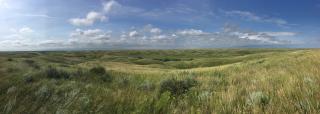Prairie grouse numbers soar on Fort Pierre National Grassland

National Grasslands Week is upon us, and the Fort Pierre National Grassland has something to celebrate. In South Dakota’s native prairie ecosystem, prairie grouse numbers have soared to record-breaking levels. Thanks to the help of many dedicated volunteers, the general public, state agencies and local district office staff, the annual spring prairie grouse surveys are complete.
Each year, Fort Pierre conducts a survey, and this year’s results tallied 1,221 displaying males, a remarkable 40% increase from last year’s record-setting numbers. The survey has been conducted for 50 years. This year, greater prairie-chicken and sharp-tailed grouse populations are the highest they have been in that time.
Fort Pierre National Grassland covers 116,000 acres of mixed-grass prairie and provides essential breeding habitat for prairie grouse. Each spring, male grouse gather at traditional display sites, or “leks,” performing elaborate dances to attract females—an unforgettable spectacle now happening in greater numbers than ever before.
Biologists attribute this boom to a combination of sustained conservation practices, favorable weather and cooperative partnerships with private landowners. Continued efforts to maintain and enhance native grasslands are vital to ensure the long-term survival of these iconic species.
Spring lek surveys on the Fort Pierre are conducted from roughly mid-March through mid-May each year. The surveys commence as the sun begins to rise across the prairie landscape. Those conducting the survey have different routes they follow each day with designated stops where they listen and scan the horizon for leks. Once a lek is found, the location is marked on a map and notes are taken on how many displaying males are counted and if the lek is greater prairie chicken, sharp-tailed grouse or both. Then the person moves on to the next stop.
These surveys are done during a time of year when weather can play a critical role in effectiveness. If it is too windy, then the birds will not display well. If the ground is snow-covered or it has recently rained, then travel across the open prairie can be problematic. Weather and ground conditions are constantly being checked.
Fort Pierre has the Cedar Creek Monitoring Unit, and data shows that over the decades the population has been on the rise. In recent years, wildlife management staff members have started branching out to survey other portions of the grassland to obtain an overall view of the population.
“This is an unprecedented milestone,” said Dan Svingen, Fort Pierre National Grassland district ranger. “It speaks volumes about the effectiveness of habitat restoration, responsible land management, and collaborative conservation efforts.”
“A special thanks to the volunteers who assisted in the spring surveys. Regarding grouse reproduction, we have very good nesting cover available, and recent May rains have further improved conditions,” said Svingen.
Grassland staff hope nature enthusiasts, bird watchers and other visitors manage to spot these species—they certainly have a greater chance than they have in the last half century.


